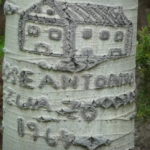
History professor John Bieter and professor and head of Special Collections and Archives Cheryl Oestreicher co-authored “Arborglyphs – Basque immigrant sheepherders left their marks on aspen trees in the American West” in The Conversation with Iñaki Arrieta Baro, a librarian and head of the Jon Bilbao Basque Library, University of Nevada, Reno.
An excerpt of the article follows:
“Throughout the mountains of the American West, carvings hidden on the trunks of aspen trees tell the stories of the sheepherders who made them as they passed through with their flocks. Most of the men who etched these arborglyphs into the living trees were Basques who, starting with the Gold Rush of the 1840s, had immigrated from the Basque Country that straddles the Pyrenees Mountains.
Our experience of documenting arborglyphs – “lertxun-marrak” in Basque – has deepened over time. At first, we simply tried to decipher what was on the tree. It can be hard to tell what is scarred bark and what is a carving. Gradually, we got better at deciphering the carvings and now hope to spot the oldest and most ornate. […]
These herders left their marks on the aspens, and now we are part of a research collaboration that aims to document and catalog as many of their arborglyphs and the experiences they record as possible before they disappear. About 25,000 arborglyphs have been documented over time, and there are likely at least as many more left to be recorded before they’re lost.”